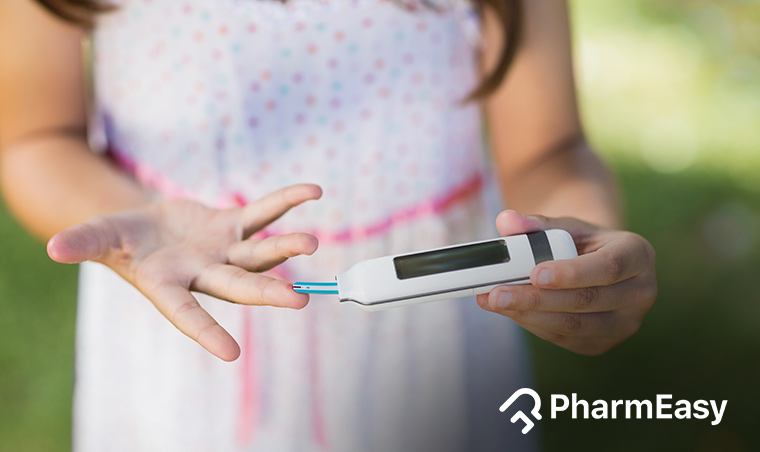Can Children Have Type 2 Diabetes?
By Shantanu Sodhi +2 more

Get more insightful and
helpful tips to
treat Diabetes for FREE



Download PharmEasy App




Register to Avail the Offer
Send OTPBy continuing, you agree with our Privacy Policy and Terms and Conditions
By Shantanu Sodhi +2 more
Diabetes is a common disease in today’s time. It is not only observed in adults but children as well.

Previously, it was thought that children could only have Type 1 diabetes but, it is now observed that they can develop Type 2 diabetes and few other types of diabetes as well.
As per the National Diabetes Statistics Report 2020, almost 210,000 children and teenagers have diabetes. In fact, Type 2 diabetes in children is rising by 4.8% every year.
Table of Contents
High blood sugar and diabetes are two terms that are used interchangeably. This is because the digestive system breaks down carbohydrates into glucose. After which, the pancreas secretes a hormone known as insulin which helps in the movement of glucose from your blood into the cells for energy.
Type 2 diabetes does not allow the cells to respond well to insulin, leading to a buildup of glucose in the bloodstream. This makes the sugar levels extremely high for the body to handle. The phenomenon is known as insulin resistance.
Children with Type 2 diabetes can develop Type 2 diabetes complications affecting the eyes, kidneys and heart. In certain cases, it can lead to blindness as well.
Type 2 diabetes symptoms in children generally show very slowly and gradually. Hence, it becomes difficult to detect early on. In fact, some children have no symptoms at all.
However, diagnosis of Type 2 diabetes can be made based on the following symptoms:
Children having Type 2 diabetes might go to the restroom more frequently as compared to before the condition developed. Usually, the body excretes the excess sugar from the blood in the form of urine with water.
Children with type 2 diabetes might be more frequently thirsty. This is because increased urination often leads to dehydration.
Before the onset of type 2 diabetes, certain areas of skin begin to darken due to insulin resistance. This includes areas around the neck, back and armpits.
High blood sugar can pull the fluid from the lenses of the eyes, making it harder for the child to focus. Children developing Type 2 diabetes might also complain about their eyes paining frequently.
Insulin resistance can lead to fatigue as the body can’t convert blood sugar levels effectively. Type 2 diabetes in children makes them easily exhausted after a minor physical activity.
Type 2 diabetes diagnosis can be made by observing sudden weight loss too. The body does not receive the proper energy that sugar supplies which leads to the shrinking of muscle tissues and fat stores.
Insulin resistance can lead to slower healing of injuries and soreness in the body.
No one knows the exact cause of type 2 diabetes. However, family genetics and sedentary lifestyle play an important role. Obesity and inactivity in kids can also lead to type 2 diabetes.
Being overweight is a type 2 diabetes risk factor for kids. Children with fatty tissue around the abdomen have a high chance of developing this disease.
Children who have a family history of diabetes can be at risk of type 2 diabetes.
Children with sedentary lifestyles are also at risk. Physical activity generally helps a child control their weight while using glucose as energy and making their cells more responsive towards insulin.
Babies that are born prematurely before 39 to 42 weeks gestation have a higher risk of type 2 diabetes.
The long-term complications develop gradually over a period. Some of the type 2 diabetes complications include:
However, keeping the child’s blood sugar levels close to normal can reduce the risks of type 2 diabetes complications.
A healthy and well-balanced life can help in managing type 2 diabetes in kids. Eating leafy vegetables, fresh fruits and whole grains is a good idea. Also, indulging children in fun physical activities and exercises can keep them healthy.
If a child already has type 2 diabetes, then healthy lifestyle changes can help in reducing the complications. Apart from that, it is always advisable to monitor your child’s health and visit the doctor immediately if you see any symptoms.
Also Read: Magnesium Deficiency: Understanding Causes, Signs, and Solutions
Disclaimer: The information provided here is for educational/awareness purposes only and is not intended to be a substitute for medical treatment by a healthcare professional and should not be relied upon to diagnose or treat any medical condition. The reader should consult a registered medical practitioner to determine the appropriateness of the information and before consuming any medication. PharmEasy does not provide any guarantee or warranty (express or implied) regarding the accuracy, adequacy, completeness, legality, reliability or usefulness of the information; and disclaims any liability arising thereof.
Links and product recommendations in the information provided here are advertisements of third-party products available on the website. PharmEasy does not make any representation on the accuracy or suitability of such products/services. Advertisements do not influence the editorial decisions or content. The information in this blog is subject to change without notice. The authors and administrators reserve the right to modify, add, or remove content without notification. It is your responsibility to review this disclaimer regularly for any changes.
Comments